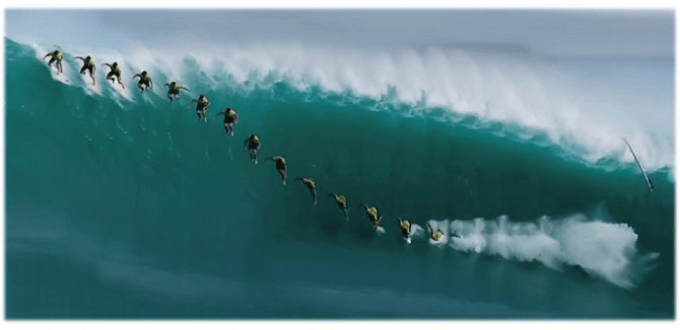Ahhh, The Eddie. Has it really been a month already? Which wave, who’s ride, and which wipeout sticks out the most in your memory? For most, it’s a no-brainer – the free-fall that Grant ‘Twiggy” Baker took in the first round. That one will stay etched in my mind for years to come. He dropped for what seemed like forever before hitting the water and tumbling like a piece of laundry. The commentators called it “horrific,” adding, “that is the worst feeling at Waimea Bay to just know that all that water is crashing in behind you.”
The first reaction was some variation of, “Holy —-, how far did he just fall?” One headline following that historic day even made lighthearted reference that his next stunt would be barreling over Niagara Falls. Based on analysis of the available footage, his actual drop height was about 29 feet. That’s from the moment he self-ejected from his board to when his body hit the water. Nothing like a three story drop to start your day right? You know high dive platforms, well those are 33 feet above the water. They are also stationary and the water beneath them is calm whereas Twig pretty much leaped off one of those as it rolled down a surging river. Sound fun? No thank you.
Falling through air is one thing. Impacting the water is another. Considering how fast he was moving once he got up on his board, combined with the pull of gravity, Baker’s body was traveling almost 35 mph (56 km/h) when he struck the water. There aren’t a lot of human comparisons for that (Usain Bolt’s highest recorded sprinting speed is 30 mph). Here’s one though – in those high-speed crash tests that we’ve all seen, the cars are going about 35 mph when they hit the wall and dummy parts start flying. Thankfully Twig hit water, not a wall, so the forces were much lower than a 35 mph car accident. But still, how does somebody turn around and paddle right back out after that? He took another nasty fall in the second round and twenty minutes later scored his highest wave of the day. That 80 point ride was topped by only four other surfers that day.
Twig told me he walked away from The Eddie feeling “very sore” and experienced whiplash-related symptoms for two weeks after the contest. That’s not surprising at all considering that volunteers in “low speed” car crashes typically report whiplash symptoms when the change in speed is in excess of 5 to 8 mph (8 to 12 km/h) in rear and frontal collisions, respectively. So apparently ‘Twig’ is human after all.
When I asked him about the fall he acknowledged that it was epic. “The freefall and subsequent mauling can actually be pretty fun as long as you don’t get injured in the process,” he says. “It’s like a crazy rollercoaster ride at the amusement park.”
Maybe that’s a part of why we can’t look away as spectators. We keep watching, in part for the brilliance, but also for the violence that is big wave surfing. We strain our eyes and necks in fascinating, yet sometimes morbid curiosity. It sounds a bit like that multi-car pileup you gawked at on the way into work this morning, doesn’t it?
This article was written by Michael Sinnott and was originally published by The Inertia. Click here to view the original post.

About The Author
Michael Sinnott
My background is in Biomechanics and Engineering. I work in Forensics, so I'm the guy that gets called to figure out what happened and why. I own BioLogic Forensics LLC, and offer forensic services out of Oahu, Hawaii. I love what I do and am passionate about people. Work related or not, I'm always investigating something. Whether I'm working or surfing or diving or fishing, I'm proud to share my stories. After all, I'm just a kid from suburban Detroit living out his dreams in Hawaii!